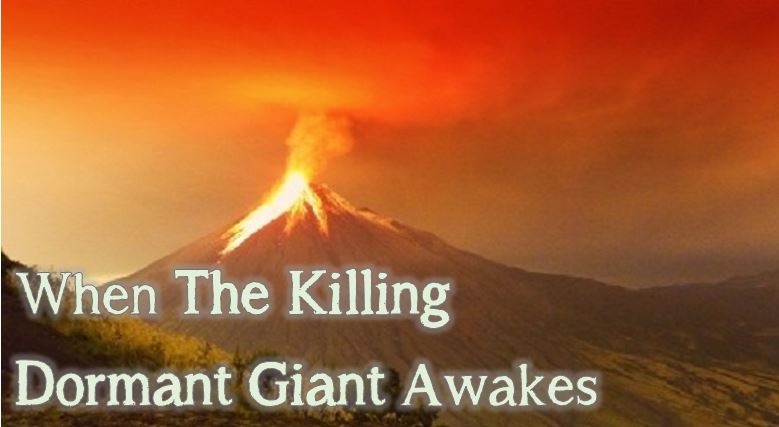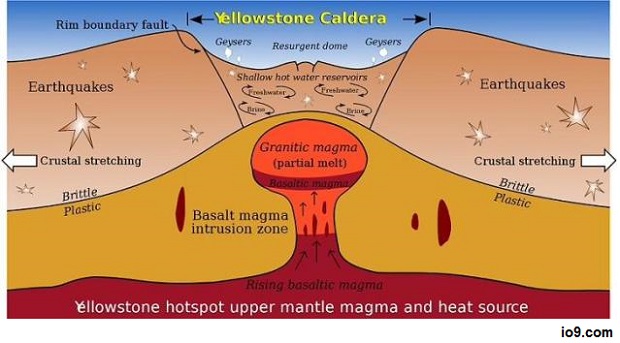Much ado has been made in recent years about the active supervolcano that resides underneath Yellowstone National Park in Wyoming but should we be prepping for it?
Is the killing dormant giant really sleeping? Is a cataclysmic supereruption possible or even probable in the near future? For that matter, is a volcanic eruption all that we should be concerned about?
If leaving aside Yellowstone, how many of us are prepared to survive a volcanic eruption?
The Yellowstone Supervolcano is located beneath the Yellowstone Caldera in the northwest corner of Wyoming. A caldera is simply a depression left in the earth from the eruption of a volcano. Think of it as a sinkhole; when the magma erupts from the earth, the land is going to sink because there’s nothing left underneath to hold it up.
The size of the caldera is huge – it measures about 45 miles by 34 miles. The size of the actual magma cove that currently lies a few miles underneath the Yellowstone Plateau is about 2.5 times as big as scientists had previously thought. It’s about 50 miles long and about 12 miles wide and the mass fills about 960 cubic miles underneath the earth. In other words, it’s long, wide and deep.
The location of the cove isn’t stationary but that’s not because the cove itself moves; the North American Plate lies about it and moves west southwest over the hotspot. This movement is so slow that it’s irrelevant to our concerns except as a means to track its historical activity.
Only about 6-8% of the magma cove is molten rock but that’s still a lot of lava! Scientists say that this proportion of lava is much too low to cause another supereruption soon, but that’s not all that we should be concerned about.
Is the Giant Really Sleeping?
Though there have only been 3 major supereruptions in the history of the volcano, it’s always active to some degree. It’s the source of the geysers in the park and also creates more than 1000 earthquakes per year, most of which are under magnitude 3.0, which is the level at which we can actually feel them. Still, they’re a regular occurrence.
Non-explosive and less explosive eruptions have happened since the last “big one” but it’s been about 70,000 years since a lava flow incident and about 150,000 years since an explosive eruption occurred. In the scheme of things, that’s fairly recent.
The first supereruption of the Yellowstone Volcano in its current location was the biggest and happened about 2.1 million years ago. It formed the Island Park Caldera and the Huckleberry Ridge Tuff, and produced 2500 times the amount of ash that the most recent Mount St. Helens eruption did!
{adinserter usf}The second supereruption occurred 1.3 million years ago and created the Henry’s Fork Caldera and the Mesa Falls Tuff, and was the smallest of the three. The third, and second largest, eruption happened 640,000 years ago, and formed the Yellowstone Caldera as well as the Lava Creek Tuff. It ejected 240 cubic miles of dust, rock and ash into the air.
In addition to the three supereruptions, there was another eruption about 174,000 years ago that created West Thumb Lake in the park.
The Yellowstone hotspot is ancient, though. Remember that the North American Plate shifts over it so the activity in Yellowstone isn’t the only place that it’s been active. The first caldera attributed to the hotspot is in southwest Central Yukon in Canada and is thought to be about 70 million years old.
The trail of calderas and overlapping volcanic fields attributed to the Yellowstone hotspot extends from there through the Nevada/Oregon border, the Snake River and finally to the current location in Yellowstone. It’s not a recent development for sure and not likely to go away soon.
The Unpredictable Eruption
There are several ways that scientists monitor the Yellowstone Volcano: they look at geyser activity, earthquakes and also the rise and fall of the terrain of Yellowstone Plateau. As the magma in the cove changes pressure, the land actually rises or sinks.
This change is typically fairly regular, with an average rise of about 0.6 inches per year, nut between 2004 and 2008, though, it rose nearly 3 inches each year. As a matter of fact, it increased by a whopping 8 inches at the White Lake GPS station. This surge in rise decreased by late 2009 according to the US Geological Survey and has since returned to “normal”.
What was it all about though? Was the volcano issuing a warning or was it just a fluke or a one-time thing?
According to scientists, it wasn’t necessarily a sign of anything but the statement that they issued from the Yellowstone Volcano Observatory wasn’t particularly comforting. They “see no evidence that another such cataclysmic eruption will occur at Yellowstone in the foreseeable future. Recurrence intervals of these events are neither regular nor predictable.”
Great. In other words, nobody knows what’s going to happen or when it’s going to blow.





















































































If the caldera actually does blow, what do we do in North Colorado? We live within 50 miles of Rocky Mountain Park, or will the Rockies also be covered with ash? What is a solution to live through the eruption. I always hear about the next catastrophe, but no one gives any solutions. It is very simple to speak about all the bad things coming our way, if you don’t have to offer any solution……Hell we will all die!!!!!
Gunter, you’ll find more answers within the second part of this article, which will be published on Sunday. Stay close and stay safe!
my friend you and yours maybe one of the lucky ones (a fast death when the roof falls in) some a little more away may like wise have a quick death as the dust turns to concrete in their lungs, but if it is a full eruption most the rest of the people in north america (maybe the world in lesser numbers) will have a long painful death of starvation the Georgia Guidestones may come close to the truth.
I read somewhere that only people who have a few years worth of provisions would be able to survive a Yellowstone eruption. True?
I am not worried at all about the Yellowstone Caldera “erupting”. I would be(and am) far more concerned about the earthquake swarms currently affecting Rainer, Hood, Shasta and Mt. Lassen. if those currently dormant volcanoes actually “blew” the results would be rather catastrophic. While the Northern Plate shifts daily, pressure is released when there is a large number of smaller magnitude temblors, in Yellowstone. While the Park itself, is a geothermic wonder(which is why it’s a National Park and protected), there are far more realistic earthquakes along the West Coast that could trigger far reaching events, to include port closures, all along the West Coast(crippling the economy), destroying the Western States vast agricultural infrastructure, including the water systems, and the ash/fallout particulates from just on of the West Coast volcanoes would create air travel and transportation nightmares. Rail service would be interrupted, and freeway (truck) transport would be severely curtailed. While Yellowstone, will surely erupt again, it IS the most closely watched geo-hotspot at present, and I’m confident that we would have an “early warning”, like we did with Mt. St. Helens eruption. Not that the fatalities incurred with that one paid a bit of attention to those warnings! So, I’m comfortable living as close as we do to the Yellowstone Caldera(about an hour by vehicle) for the time being. There are far greater threats we need to be prepared for as the author suggests in her article.
Cubic miles is not a unit of mass.
“mass of about 960 cubic miles”
Good eye and it’s corrected. It takes up about 960 cubic miles of space under the earth. Thank you! 🙂